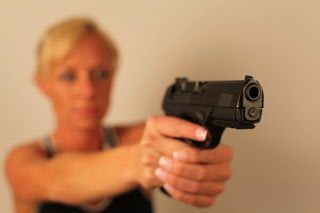The only way to become a better marksman is to practice. Unfortunately, most of us do not have the time or money to be at the range once a week, let alone every day. Thankfully, there is a way for gun owners to safely practice their shooting skills in their homes that cost little to nothing. Dry firing is simply practicing without the use of live ammo. If you aren't integrating dry fire practice into your training yet, now is the perfect time to start.![]()
 The Benefits of Dry Fire Training
The Benefits of Dry Fire Training
Anyone from a target shooter to a police officer can improve their skills with dry fire training. Repetition builds consistency and muscle memory, which is key to accuracy. Dry firing is training without ammunition. Recoil management is the only aspect of marksmanship that requires live ammunition. However, there are dry fire laser trainers with recoil. Grip, sight picture/sight alignment, and trigger press can all be practiced without firing a single round.
Advanced techniques such as drawing from a holster or utilizing a weapon light can also be improved upon by dry fire practice. For competitive shooters and self-defense, it builds skills in everything from trigger control to target acquisition and reloads. You can dry fire practice with any type of firearm, not just handguns.
Dry Fire Training Tips & Gear
The key is to focus on your mechanics, and much like weight lifting, only quality reps count. Start slow, and if you already know the areas you are weak in, such as your grip or reloads, then you can spend time just working on that part. Break each movement down into steps if you can, like only clearing a cover garment and just acquiring a solid grip. The fundamentals you build will help you regardless of what shooting discipline you participate in. If you can, try to dry fire in the same clothing and gear you would wear during live fire. For competitors, that means ear protection, safety eyewear, reloads, etc. For defensive shooters, that means in your typical concealed carry attire.
While you can practice dry fire drills almost anywhere for free, there are some items that you may want to use to enhance your practice. Snap caps or dummy rounds help protect the firing pin from damage, which is especially crucial for rimfire rifles. A shot timer is a great tool to gauge where your current skill level is and to push yourself to improve. Laser Trainers are great for visual feedback and can be paired with special targets that react to the laser. Some training systems can attach to a pistol or rifle and provide feedback via a linked smartphone app, like the Mantis X Shooting Performance Systems. These devices can be used with dry fire or live fire, making them versatile tools that are well worth the investment.
Regardless of what training tools you dry fire practice with, putting in work to have solid mechanics is what matters. By building your fundamentals, you will be a better shooter in any scenario or discipline. As always, remember to follow all firearm safety rules, even if you’re not practicing with live rounds.




